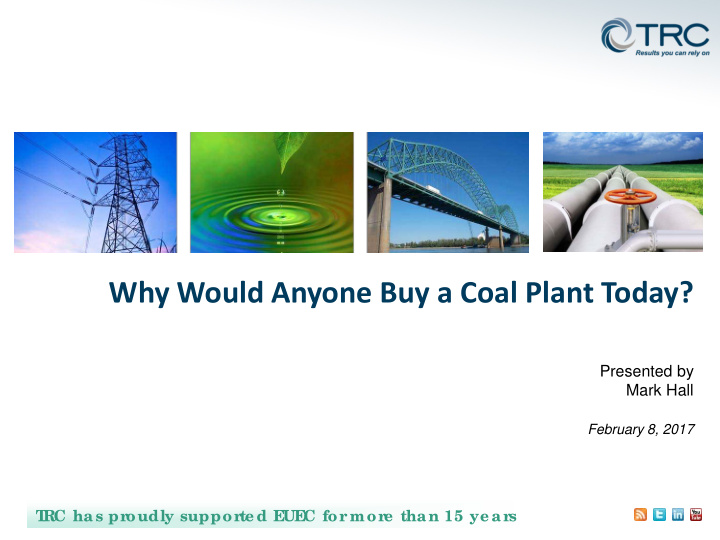



Why Would Anyone Buy a Coal Plant Today? Presented by Mark Hall February 8, 2017 T RC has pr oudly suppor te d E UE C for mor e than 15 ye ar s
Agenda The setting for coal-fired generation Possible rationale for buying coal fired generation assets in today’s market Additional considerations when making that investment decision 2
North America Market Conditions The power generation market continues to experience significant turnover with the retirement of coal and nuclear assets and significant growth in utility scale renewables (principally wind and solar) Electric production from gas now regularly exceeds that from coal with renewables rapidly gaining market share
North America Market Conditions (Cont) Power Market, US, Cumulative Installed Capacity (GW) U.S. electricity demand has and Annual Power Generation (TWh), 2000–2025 been relatively flat and only modest growth is expected Regional demand in the Southeast and Southwest will require more capacity as reserve margins shrink Other US regions will see replacement of coal and nuclear with renewables and gas coupled with demand response Regulatory drivers include tax credits and portfolio standards, air and water regulations Title: US Power Market Outlook to 2025, Update 2015 – Market Trends, Regulations, and Competitive Landscape Reference Code : PEPEC47068 Publication Date: November 2015 GlobalData
Setting for Coal Natural gas price plus gas turbine efficiency advantage has propelled gas assets to a lower cost position in the supply stack Substantial increase in installed renewables further depresses demand for coal Future environmental requirements create additional economic pressure (ELGs, 316(b), PM 2.5 NAAQS, State CO 2 standards)
Coal Retirements Coal Capacity Retirements (MW) Retirements peaked in 2015 with deadline for MATS compliance. Significant retirements will continue for economic reasons without Clean Power Plan State action to support renewables and reduce carbon emissions have potential to cause another step change in rate of retirements Source: UBS, Fanning the Flames of Retirement, May 20, 2016
So Why Would Someone Buy an Old Coal Plant? Cheap capacity – some recently announced transactions are well below $300/MW • If you can get a reasonable capacity payment, cut OpEx and avoid too much dispatch, there is money to be made in short term Run it till it dies – minimize CapEx Get lucky – owning a portfolio gives you a better chance of getting a reliability must run type contract or similar bailout until other transmission or generation gets built • Severe weather like the polar vortex provides another opportunity to cash in
How are Buyers Dealing with Future Liabilities? At some point, any given coal-fired asset will not be worth running or maintaining in ready-to-run condition Quantifying that liability is not straightforward Options that some market participants are employing • Cold Shutdown • Plant Demolition and Site Redevelopment • Bankruptcy 8
Cold Shutdown In many respects this is the easiest strategy and preserves some future options The activities typically include de-energizing equipment and systems, removal of any fuels, sale or transfer of spares. Goal is Cold, Dark and Safe Caretaker staff or even just security Opportunistic scrapping Minimize taxes (requires approaching taxing authorities) Wait • Possible repower scenario in the future • Possible improvement in steel scrap value Don’t dig! The cardinal rule for most of these owners is don’t do anything to trigger a cleanup obligation Costs – Moderate ongoing costs
Plant Demolition and Site Redevelopment Less common than cold shutdown Driver principally high redevelopment potential • Plants in urban areas with expensive real estate and waterfront property or unique infrastructure High scrap value for steel historically allowed for plants to be demolished at near a net $0 cost but average cost is around $15 million today Dealing with asbestos, lead paint and PCBs can be significant part of the cost Outside of areas with high potential for redevelopment, structures often removed to grade but no subsurface work occurs • Plants with on site CCR impoundments will have ongoing monitoring obligations A number of power plants demolished in past decade (TRC involved in 32)
The Bankruptcy Strategy Private equity has been setting up LLCs for plants and portfolios for years with expectation that if market conditions dictate they could shut down and walk away. My limited survey of a few law firms is that this can be very tricky to execute. Need to be aware of state and local regulations that could effect the success of this strategy. Should have an alternative plan and understand the potential costs for those alternatives. • Demolition • Cold Shutdown
Initiatives Around Transforming Cold Sites, Accelerating Redevelopment and Demolition Power plants have unique infrastructure, on reasonably large sites Towns and Economic Development Authorities would love to see these sites providing jobs and generating tax revenues The biggest impediment has been liability management PA Department of Commerce and Economic Development example
Questions? Mark Hall P: (630) 292-3914 | E: MHall@trcsolutions.com
Recommend
More recommend